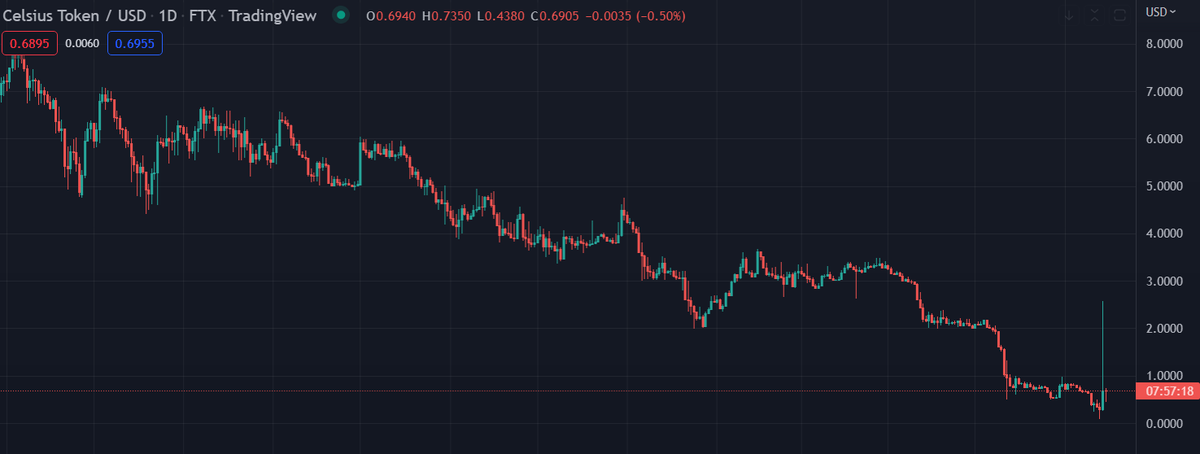THREAD: How @CelsiusNetwork might collapse as @terra_money did ?
Celsius is a protocol that managed more than $12 billion at its peak and is now facing a possible bank run.
Let’s dive on what is happening 🧵
Celsius is a protocol that managed more than $12 billion at its peak and is now facing a possible bank run.
Let’s dive on what is happening 🧵
First, let’s take a look at what is Celsius.
Celsius is similar to traditional hedge funds, the company manages assets on investor’s behalf while returning a fixed yield.
1/32
Celsius is similar to traditional hedge funds, the company manages assets on investor’s behalf while returning a fixed yield.
1/32

The service uses its investors' funds to earn yields on complex #DeFi loops while taking a service fee.
This process is called #CeFi (Centralized Finance) and is used by platforms like @Nexo or @BlockFi.
2/32
This process is called #CeFi (Centralized Finance) and is used by platforms like @Nexo or @BlockFi.
2/32
A lot of users were seduced by such offers as it allows them to stay out of the #DeFi complexity and risks while earning a fixed rate on their holdings.
3/32
3/32

Even if the methods are equivalent to traditional hedge funds, @CelsiusNetwork claims itself as an unbanking platform where users can withdraw at any time.
4/32
4/32
Ironically, Celsius raised $750 million through a serie B funding round led by West Cap and Caisse de dépôt et placement du Québec (CDPQ).
5/32
https://twitter.com/CelsiusNetwork/status/1463616618316005377?s=20&t=P-Lsy6GkXQOWLj208V_BHw
5/32
Despite all the cash beared by equity and assets under management, Celsius is possibly facing a bank run.
How is it possible ? Mainly due to bad and risky decisions. ⬇️
6/32
How is it possible ? Mainly due to bad and risky decisions. ⬇️
6/32
First, let's talk about @terra_money. This protocol offered staking solutions where anyone could get yield on an algorithmic backed stable coin $UST based on the dollar value.
7/32
7/32
Due to the market crash, unhealthy yields and liquidity issues, the $UST couldn’t maintain its $1 stable value, leading to the evaporation of $40B from the market.
8/32
8/32

During the crash, and regarding the on-chain analysis, Celsius were exposed up to $500m to the protocol and might have lost all of it.
nansen.ai/research/on-ch…
9/32
nansen.ai/research/on-ch…
9/32
The second reason and the biggest one is the $stETH issue.
Celsius has offered incredibly high yields on $ETH, almost twice higher than the market does.
10/32
Celsius has offered incredibly high yields on $ETH, almost twice higher than the market does.
10/32
In order to achieve such yields, they have used what’s called $stETH, a product created by @LidoFinance that allows you to earn ethereum staking rewards while not having to stake your $ETH.
11/32
11/32
Such innovative products are risky and Celsius has invested more than 70% of their $ETH into Lido.
The strategy was to stake the staked ethereums in protocols such as @CurveFinance, creating leveraged positions.
12/32
The strategy was to stake the staked ethereums in protocols such as @CurveFinance, creating leveraged positions.
12/32
$stETH is worrying as it has lost its peg/price correlation with $ETH and isn’t anymore 1:1, resulting in an Asset Under Management (AUM) depreciation for Celsius.
As an example, it means a user lends 10 $ETH that are now worth 9 ETH, Celsius still owes 10 ETH.
13/32
As an example, it means a user lends 10 $ETH that are now worth 9 ETH, Celsius still owes 10 ETH.
13/32
In addition to it, all of the $stETH are locked until the merge.
14/32
https://twitter.com/daotopiaVC/status/1533530957717831680?s=20&t=pmHsLXfoHSs43xPQi1AY1g
14/32
… and cannot be redeemed for at least 6 to 12 months
15/32
https://twitter.com/LidoFinance/status/1536756940419784704?s=20&t=oxMQGlGpmoyRx25AUFm1ww
15/32
Even if the $stETH were redeemable, there wouldn’t be enough liquidity for @CelsiusNetwork to swap it back to $ETH, as they currently own 409k ETH while @CurveFinance stETH pool has only 129k ETH.
16/32

16/32


All of this led Celsius to close withdrawals
17/32
https://twitter.com/CelsiusNetwork/status/1536169010877739009?s=20&t=dDozy3nSP-P6vFBbSCENDQ
17/32
Unfortunately the mess has just started, Celsius had in the past contracted debts through @MakerDAO protocol to get a higher yield on their products (as they would have more tokens to manage).
18/32
18/32

While contracting debts with volatile assets on Maker, you need to be over-collateralized to get your loan.
It means if you want to borrow 1 $ETH, you need to put 1,5 ETH as collateral.
19/32
It means if you want to borrow 1 $ETH, you need to put 1,5 ETH as collateral.
19/32
This will protect the lender from asset devaluation, which is actually happening because of the past month's market drop.
When your 1.5 ETH value falls close to the 1 $ETH value you've borrowed in the past, you get what’s called a margin call.
20/32
When your 1.5 ETH value falls close to the 1 $ETH value you've borrowed in the past, you get what’s called a margin call.
20/32
The lender requires more collateral to keep the position or he will run away with the 1 $ETH to cover the lend.
Then you have 2 choices, either you add collateral and hope for a market reversal, or you simply repay your debt (if you have liquidity).
21/32
Then you have 2 choices, either you add collateral and hope for a market reversal, or you simply repay your debt (if you have liquidity).
21/32
@CelsiusNetwork chose to add collateral to their positions. Thus, in the past few days more than 7000 $WBTC ($154M) were added in collateral
(Reducing as well the $DeFi exposition, hence benefits for investors)
defiexplore.com/cdp/25977
22/32
(Reducing as well the $DeFi exposition, hence benefits for investors)
defiexplore.com/cdp/25977
22/32

(Such positions on the edge of liquidation are often hunted by market makers or trading desks, as what might have happened for $Luna, to earn fees on the liquidation process)
Now you’re probably wondering how much funds Celsius currently have ?
23/32
Now you’re probably wondering how much funds Celsius currently have ?
23/32
Celsius known wallets are now worth $1,6B with $750M of it being debts
zapper.fi/bundle/0x8acea…
The rest of the funds might be lost, put on unknown wallets, #CEX or elsewhere.
24/32
zapper.fi/bundle/0x8acea…
https://twitter.com/sgallardo_9/status/1536311772193382401?s=20&t=fkl2b8G4v7f5x39NB67UFA
The rest of the funds might be lost, put on unknown wallets, #CEX or elsewhere.
24/32

Celsius has now 5 solutions:
- Dumping its $232,903,498 worth of $CEL token holdings to get cash
- Stopping withdrawals (and of course continue deposits) until stability and liquidity come back.
26/32
- Dumping its $232,903,498 worth of $CEL token holdings to get cash
- Stopping withdrawals (and of course continue deposits) until stability and liquidity come back.
26/32

- Getting bailed out by competitors or institutions. @Nexo has already publicly published a letter of intention to acquire Celsius assets.
Celsius has now until the 20th of June to accept or decline the offer.
27/32
https://twitter.com/Nexo/status/1536256598993211393?s=20&t=pmHsLXfoHSs43xPQi1AY1g
Celsius has now until the 20th of June to accept or decline the offer.
27/32

- Restructuring the company to reduce costs
- Getting liquidated by margin calls and thus going for bankruptcy
28/32
https://twitter.com/WSJ/status/1536864851250790400?s=20&t=vAskP1LG6Hon5R28dAw_Bg
- Getting liquidated by margin calls and thus going for bankruptcy
28/32
@CelsiusNetwork is showing once again that centralized protocols are opaque and funds are not #SAFU.
#Bitcoin has been created to avoid third parties and traditional finance errors such as bank runs and over-leveraging, yet the same mistakes continue to be made.
29/32
#Bitcoin has been created to avoid third parties and traditional finance errors such as bank runs and over-leveraging, yet the same mistakes continue to be made.
29/32
As of now, it’s a 1.7 million user base that cannot withdraw or use their funds, Celsius has to recover barely $9B if they want to solve every customer loan.
30/32
30/32
The market stabilization could help to go in that direction, but we’re afraid that after all these events and lies, trust between investors and the project has been lost in the same way as $Luna and $UST did.
31/32
31/32
If you’ve enjoyed this presentation let us know your thoughts on the situation and what you think will happen.
You can also support us by giving a follow and a RT to the post below !
Cheers
32/32
You can also support us by giving a follow and a RT to the post below !
https://twitter.com/daotopiaVC/status/1537112335462047745?s=20&t=qJL2N4gkKoUNyF-Adm8u2Q
Cheers
32/32
Useful links :
curve stETH pool curve.fi/steth
curve borrow position defiexplore.com/cdp/25977
All Celsius adresses
curve stETH pool curve.fi/steth
curve borrow position defiexplore.com/cdp/25977
All Celsius adresses
https://twitter.com/MikeBurgersburg/status/1517564563176239107
• • •
Missing some Tweet in this thread? You can try to
force a refresh











